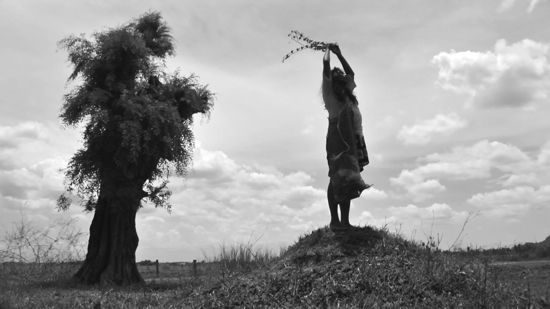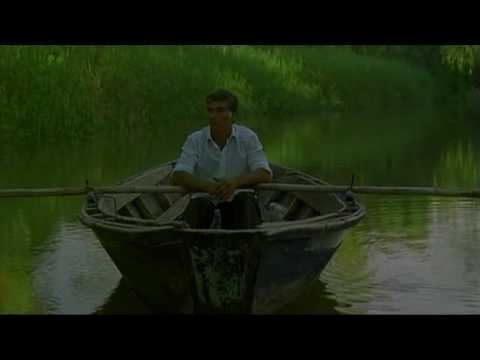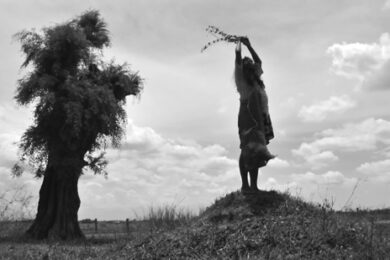"Those who follow my films are well prepared – they are warriors! They are formidable. They sleep and eat well before and then have a two-hour intense discussion afterwards." – Lav Diaz
For the two days I experienced of AV Festival, this quote from Filipino filmmaker Diaz, spoken at the opening panel discussion, was repeated many times as an audience travelled through films of long duration and slow pace. Warriors might be pushing it, but it was interesting how we did become a community: a loose gang of committed and engaged viewers, experiencing a concentration of films that required a different language of spectatorship to most cinema.
Taking place biannually since 2006, AV Festival has now cemented itself as a thoughtful space for the contemplation of hot topics in moving image, and alongside events like Arika and Abandon Normal Devices in the UK, it genuinely seems to push the discourse forward. In AV’s previous edition, themed around ‘Energy’, the exploration of archives and artists using found footage was particularly illuminating. It felt like a moment when the work of such disparate filmmakers as John Akomfrah, Adam Curtis, Craig Baldwin and Vicki Bennett was ripe for a focus where audience exposure and critical examination collide.
This year the theme is ‘As Slow As Possible’. As festival director Rebecca Shatwell explained, this was partly a response to accelerated technology, partly a response to the Olympics – with its "Faster, Higher, Stronger" motto – and partly a conscious effort to effectively slow audience engagement down. If a festival generally involves a short period of time where people are rushing to cram in as much as possible, how does that impact on our ability to reflect on the things we experience? With a whole month to itself, AV Festival spans Newcastle, Gateshead, Middlesborough and Sunderland and covers art, experimental music and cinema, with different artforms and aspects of the programme having their highlighted moments on different weekends.
And so to last weekend. Slow Cinema is a controversial term that has already inspired much debate, from the argument spun out
from a Sight & Sound editorial, to a New York Times ‘in defense of slow and boring’ . While some see the filmmakers held under this banner as a new unofficial cinephile canon – those represented at AV include Alexander Sokurov, Carlos Reygadas, Abbas Kiarostami, Albert Serra, Pedro Costa and Jia Zhangke – others find that the style has been adopted as a stifling critical orthodoxy, its tendencies championed more highly than other forms.
As Diaz pointed out on the panel discussion, the term and its contested nature is the concern of critics, programmers and academics, with Ben Rivers agreeing that he had never sat in a bar at a festival and discussed Slow Cinema with another filmmaker, and it was not an articulation that ever occurred to him in the creative process. So it was left to academic Matthew Flanagan to draw a line from Antonioni and European post-war representations of reality, through to the American structural film of Andy Warhol and Michael Snow, suggesting SC’s origins are in the convergence between these two traditions. Curator George Clark argued for a wider political context too, as the films are in opposition to a mode of viewing that we have been trained into: the standard 90 minutes length for a feature has been defined not by artistic will, but by the commerce of cinema exhibition. He suggested that duration as a political practice extends from Jean-Luc Godard using it as an anti-illusionistic device to Warhol’s representation of time and people on screen, via the works of Kiarostami or Apichatpong Weerasethakul, which are deeply political in themselves.
The most unifying factor of the programme was that few of the selected pictures have received UK distribution, so this was a rare opportunity to view them in the cinema environment for which they were intended. My festival kicked off properly with a cracking Lisandro Alonso double bill. La Libertad (2001) follows a day in the life of Misael, a woodcutter in the Argentinean forest, building a picture of the various rhythms of his day as he chops and sells his wood, naps, smokes and eats. Delighting in capturing the dead space of labour, the film turns tiny moments into events. The camera constantly stands a little too close: sitting in the front row the film takes on an almost 3D-like spectacle, as the machete is swung back before a chop, or a tree lands inches from our view. Even our hero’s defecating on the forest floor is imbued with a formal rigour, albeit as one of the few self-conscious moments that paradoxically reminds us of the film’s artifice. Whereas in contrast the gutting and eating of an armadillo, goes through phases of being comedic, visceral and even soulful.
Los Muertos (2004) also finds a man on a journey through the landscape, although it’s mildly more plot-driven, as we follow handsome enigma Vargas, as he is released from prison and makes his way by car, foot and boat to see his daughter. The film is imbued with a menace from the dramatic opening shot, where we swerve through a forest to focus briefly on the dead bodies of two children. Throughout the film Vargas’ relationship to this scene remains ambiguous: is this his past or his future? At one point a boatman asks if it’s true that Vargas killed his brothers and he offhandedly replies that he can’t really remember that stuff. But we see what an efficient killer he is via his swift slaughter of a goat, and the soundtrack seeds further unease as natural sounds are faded low at pivotal moments or a deep rumble emerges, the film heading towards a genuinely frightening denouement.
Introduced by Jonathan Romney as "as nocturnal as they get", next up was Nightfall (1999, aka Abendland) directed by Germany’s Fred Kelemen (well regarded for his cinematography for Hungarian director Béla Tarr). Set during a long night of the soul where an estranged couple seek redemption in a deep abyss of sadness, this thriller is populated by broken people with torn hearts. They subject themselves to sexual humiliation in retaliation for lovers’ slights, or sacrifice themselves in brutal ways to appease calamity, when all the while there is someone willing to sell them out. Mixing 35mm longtakes with grainy video close-ups, the visuals are incredibly attractive in their underworld gloom and the characters have a strangely appealing habit of standing outside the places that they have just left, lingering in the doorways of hopeless bars as the camera makes a slow retreat away from them.
But the film is also troubling. Does it earn the murders presented? It is a function of many Hollywood productions – and of our suspension of disbelief – that murders can occur and be swiftly digested and forgotten by audiences. They do not devastate, because the value of life in these pictures is negligible and only in service to the plot. But in other movies the value of truth and death is greater, the balance more subtle. Do we weigh up the severity of the crimes placed before us and ask for a greater justice than the film can offer? In Nightfall, for example, we are confronted by the disappearance of a child, whom we later see taken into a room and set before a group of men, one of whom has a camera. This set-up, implying a prelude to her group rape or at least some form of paedophilia and eventual murder, is an act that jolted me away from the other characters’ troubles, unable to follow any subsequent action without wondering what had happened to her. The scene’s vividness outweighed the film’s ability to hold it.
As a first introduction to the work of Lav Diaz, Heremias Book II is – at merely two hours – a relative short, but forms a segment of what will eventually be a much longer film. This instlament takes place in two time spans: the title character is depicted as a child going about family life as his father succumbs to leprosy, while a parallel adult Heremias visits his parents’ grave. The movie was filmed on lo-fi digital video, in black and white, with wide shots that rarely move, but contain all the discussion necessary within the frame. It’s remarkable for the way the story unfolds in a collective capacity, privileging no one character’s perspective above the rest. A family who has been left behind turn to myth and each other for hope, imbuing the work with an immense sadness, which lingers in the mind.
Saturday morning starts with Slow Action (2011), a post-apocalyptic anthropological sci-fi by Ben Rivers. Each of its four parts details the utopia of a different island, a voiceover intoning its geographical qualities and societal make-up, with the oddly beautiful hand-processed 16mm footage both chiming with and disconnecting from the bizarre illustrations of the spoken word. Touching on issues of colonialism and the conditions for revolutionary action, while keeping an absurd humour, it’s a total pleasure and well worth seeking out, alongside Rivers’ forthcoming feature release Two Years At Sea.
The weekend’s centrepiece was Lav Diaz’s Melancholia, the eight-hour epic from 2008 that all us warriors were looking forward to. We start in the small remote town of Sagada, where a prostitute, a nun and a pimp are eking out an existence in the rainy and secluded streets. In long takes we mainly watch them walking to and fro as days stretch out and they ply their wares. But as their lives start to intersect it becomes apparent that something is amiss in their identities, and as the film moves into its second and third phases we are asked to re-evaluate what has passed before.
Melancholia deals with the political situation under successive occupations and military regimes in the Philippines. Diaz communicates the loss felt by the people left behind, whose friends, lovers and families have been disappeared in the wake of failed revolutions. The picture succeeds at being both moving and entirely unpredictable, with the narrative constantly swerving and shifting focus, from minutiae to grand themes.
The festival presented it with a couple of intervals. During the second, around the six-hour mark, tables and chairs were put together in the Star And Shadow Cinema’s bar space, so everyone could have a shared meal. When the film was over, we each rejoined the table with a beer and the post-screening Q&A was conducted in the most equal way I’ve seen, audience members taking turns to ask the director questions.
Moments of collective experience like this are what festivals should be about. It was clear from details such as the timing of a James Benning screening – with the audience entering in the daytime and leaving as twilight fell – to the way that viewers, filmmakers and critics were encouraged to fraternise, that an immense amount of thought and planning had gone into every aspect of the Slow Cinema weekend. As such this was an invigorating experience that offered the films the contemplation they deserved.
AV Festival continues until March 31; more information here.




